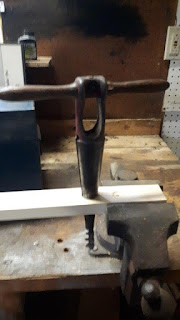The tool make a graduated tapered hole, called the bung hole
The bung, being made of wood, cork or rubber, having a matching taper will make a good seal.
Often two bungholes would be made.
The first one in the middle of the barrel, at its highest location when laying on its side, which was used for filling the barrel (or whatever vessels)
The second one, with the barrel now standing up, would be bored on one side of the head, near the rim, opposite the filling bung. That would be the one that would receive a tapered wooden or metal tap for dispensing liquid.
The first models of bung borer used the age old pattern of a simple tapered spoon, later more sophisticated model would appear, numerous patented.
Top one is like my model
Bottom is the older tapered spoon shape
Pic from New Zealand Vintage Tool Collection Club
The Swan patented borer
The Brockett patented borer
This is how this one came to be in my shop.
These items, including Rudy, followed me home (Tm) the end :-)
These tools, all came from Beans Antique and Collectibles, here in Wilmot.
Price tags were $73, they gave it to me for $57 tax in.
They changed their pricing by the way no longer everything 50%
Happy for what I got, worth it. And yes, I'm a good customer :-)
Now let see what I got and why
CW from top
Hand auger handle, Bung borer and matching wooden spigot tap
The hand auger handle is destined to fix a current auger with a loose (worn out) handle)
My new handle appear a good fit, and now I have
an historical model to turned new ones.
The original on this one (or a replacement) was roughly hand carved, not turned.
Also appears to be a soft wood?
A subject for another post, lets have a closer look at the remaining, related, objects
Rudy getting a closer sniff
See a difference is handle sizes?
That tell you a lot about the force to be exerted between these two tools
They were used as such
Ad from the 1880s for Enterprise Mfg Co of PA.
They were an hardware specialties company, better known for their mill grinders.
Top three pics from Etsy.
I do not know if mine is indeed such a model, but I can't see how mine would keep the chips inside the tool??
The one in the above ad has a short thread of the cutting bit (part of it enclosed inside hollow taper cylinder?), mine is longer exposed and there are no way the chips can slide inside the tapered hollow cylinder.
The bit is solidly fixed at the tip, there are no spaces between
the top of the tip and the inside of cylinder
Other than that the construction appear identical.
Turned hardwood handle is fixed to top of tool casting by one small 5/8 wood screw.
Yes look funky, but that is the correct size flat screwdriver.
Grace tools saw screwdriver, perfect fit.
The wooden spigot I found seems to be a good match.
I suspect they long settled on a "standard" taper by then.
I wonder if it is the same taper used in chair's building? Because if, so they would make a handy source of tapering tool for chair making. Expect to pay about Cdn $35-50 for one of these, which is much cheaper than new customs chair making one's.
Construction:
The body is cast then the tapered cone and cutting lips are machined. Short auger bit is affixed at the end. Turned wood handle is secured by a single wood screw.
Cutting lip, bottom, is sticking out ever so slightly from the body.
You can see some nicks on the edge.
Take care in sharpening to only touch the inside of the lip,
never the outside or you risk changing the outside diameter
and lowering the cutting lip. If you look closely inside the bottom, the auger bit is peened inside
A look at the wooden spigot
Made up of three turned parts.
The main tapered part is cross drilled
Internal "conduit" is 3/8 dia
The Bung borer would benefit no doubt from a quick sharpening touch up, but
let's give it a spin and see how it perform, as found...
Using a piece of hardwood, since barrels are mostly oak
This is harder than oak, but the cutting lips of the auger are not engaging.
In its defense, it is hard to apply much pressure from the height I am using it.
OK, so lets try on soft wood, pine
It kind of work, but it chew more than it cut
Typical mangled surface left from a bit in need of a tune up
At that rate, it would be a while before we get the tapering action involved. Lets try drilling a hole to start it.
I just grab a bit, found out later, it was a 1 in bit
Forstner bit laying at about the 1 inch dia. on the borer
It is graduated at 3/4, 1, 1-1/4 and 1-1/2 in
The piece of stock I'm using is 3/4 in
Yea, it kind of start a bit high up
After a few turns.
It is easy to get carry away, its fun :-)
Yes, it is tearing going against the grain.
Will be improved after sharpening.
Remember this is "as found".
Now let see how the tap fit.
Simply pushed in by hand.
Pretty darn tight on the inside surface of the vessel.
And this is just hand tight. In use they would be tapped in with a mallet.
Of course we had tear out on the front face.
But I am pretty sure once wet, this will make a leak proof connection in the back
Which can only be improved by sharpening it correctly.
Just a touch up really.
Interesting find, and now I know how it works.
Sharpening, is added to my to do list Vol 3 page 6.
Meanwhile...
... Better start clearing out that table and clean up
my wood chips before she gets home :-)
Bob, putting stuff away while shuffling more stuff





































